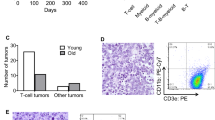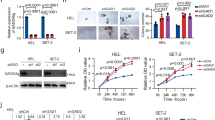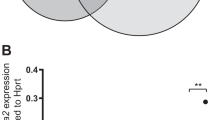Abstract
Gadd45a−/− and p53−/− mice and cells derived from them share similar phenotypes, most notably genomic instability. However, p53−/− mice rapidly develop a variety of neoplasms, while Gadd45a−/− mice do not. The two proteins are involved in a regulatory feedback loop, whereby each can increase the expression or activity of the other, suggesting that common phenotypes might result from similar molecular mechanisms. Mice lacking both genes were generated to address this issue. Gadd45a−/−p53−/− mice developed tumors with a latency similar to that of tumor-prone p53−/− mice. However, while p53−/− mice developed a variety of tumor types, nearly all Gadd45a−/−p53−/− mice developed lymphoblastic lymphoma (LBL), often accompanied by mediastinal masses as is common in human patients with this tumor type. Deletion of Gadd45a in leukemia/lymphoma-prone AKR mice decreased the latency for LBL. These results indicate that Gadd45a may act as modifier locus for T-cell LBL, whereby deletion of Gadd45a enhances development of this tumor type in susceptible mice. Gadd45a is localized to 1p31.1, and 1p abnormalities have been described in T-cell lymphomas. Related human tumor samples did not show Gadd45a deletion or mutation, although changes in expression could not be ruled out.
This is a preview of subscription content, access via your institution
Access options
Subscribe to this journal
Receive 12 print issues and online access
$259.00 per year
only $21.58 per issue
Buy this article
- Purchase on Springer Link
- Instant access to full article PDF
Prices may be subject to local taxes which are calculated during checkout



Similar content being viewed by others
References
Hildesheim J, Fornace AJJ . Gadd45a: an elusive yet attractive candidate gene in pancreatic cancer. Clin Cancer Res 2002; 8: 2475–2479.
Hollander MC, Sheikh MS, Bulavin DV, Lundgren K, Augeri-Henmueller L, Shehee R et al. Genomic instability in Gadd45a-deficient mice. Nat Genet 1999; 23: 176–184.
Hollander MC, Fornace AJJ . Genomic instability, centrosome amplification, cell cycle checkpoints and Gadd45a. Oncogene 2002; 21: 6228–6233.
Tarapore P, Fukasawa K . Loss of p53 and centrosome hyperamplification. Oncogene 2002; 21: 6234–6240.
Sah VP, Attardi LD, Mulligan GJ, Williams BO, Bronson RT, Jacks T . A subset of p53-deficient embryos exhibit exencephaly. Nat Genet 1995; 10: 175–180.
Lee JM, Abrahamson JL, Kandel R, Donehower LA, Bernstein A . Susceptibility to radiation-carcinogenesis and accumulation of chromosomal breakage in p53 deficient mice. Oncogene 1994; 9: 3731–3736.
Hildesheim J, Bulavin DV, Anver MR, Alvord WG, Hollander MC, Vardanian L et al. Gadd45a protects against UV irradiation-induced skin tumors, and promotes apoptosis and stress signaling via MAPK and p53. Cancer Res 2002; 62: 7305–7315.
Bulavin DV, Kovalsky O, Hollander MC, Fornace AJJ . Loss of oncogenic H-ras-induced cell cycle arrest and p38 mitogen-activated protein kinase activation by disruption of Gadd45a. Mol Cell Biol 2003; 23: 3859–3871.
Donehower LA, Harvey M, Slagle BL, McArthur MJ, Montgomery CAJ, Butel JS et al. Mice deficient for p53 are developmentally normal but susceptible to spontaneous tumours. Nature 1992; 356: 215–221.
Perotti D, Pettenella F, Luksch R, Giardini R, Gambirasio F, Ferrari D et al. Molecular analysis of 1p32 genetic involvement in pediatric T-cell non-Hodgkin's lymphoma. Haematologica 1999; 84: 110–113.
Barlow C, Hirotsune S, Paylor R, Liyanage M, Eckhaus M, Collins F et al. Atm-deficient mice: a paradigm of ataxia telangiectasia. Cell 1996; 86: 159–171.
Kleihues P, Schauble B, zur Hausen A, Esteve J, Ohgaki H . Tumors associated with p53 germline mutations: a synopsis of 91 families. Am J Pathol 1997; 150: 1–13.
Khanna KK . Cancer risk and the ATM gene: a continuing debate. J Natl Cancer Inst 2000; 92: 795–802.
Harris AW, Pinkert CA, Crawford M, Langdon WY, Brinster RL, Adams JM . The E mu-myc transgenic mouse. A model for high-incidence spontaneous lymphoma and leukemia of early B cells. J Exp Med 1988; 167: 353–371.
Johnston JM, Carroll WL . c-Myc hypermutation in Burkitt's lymphoma. Leukemia Lymphoma 1992; 8: 431–439.
Blain SW, Scher HI, Cordon-Cardo C, Koff A . p27 as a target for cancer therapeutics. Cancer Cell 2003; 3: 111–115.
Salvador JM, Hollander MC, Nguyen AT, Kopp JB, Barisoni L, Moore JK et al. Mice lacking the p53-effector gene Gadd45a develop a lupus-like syndrome. Immunity 2002; 16: 499–508.
Ehrenfeld M, Abu-Shakra M, Buskila D, Shoenfeld Y . The dual association between lymphoma and autoimmunity. Blood Cells Mol Dis 2001; 27: 750–756.
Poiesz BJ, Poiesz MJ, Choi D . The human T-cell lymphoma/leukemia viruses. Cancer Invest 2003; 21: 253–277.
Thomas DA, Kantarjian HM . Lymphoblastic lymphoma. Hematol Oncol Clin North Am 2001; 15: 51–95, vi.
Acknowledgements
This project has been funded in whole or in part with Federal funds from the National Cancer Institute, National Institutes of Health, under Contract No. N01-C0-12400.
Author information
Authors and Affiliations
Corresponding author
Rights and permissions
About this article
Cite this article
Hollander, M., Patterson, A., Salvador, J. et al. Gadd45a acts as a modifier locus for lymphoblastic lymphoma. Leukemia 19, 847–850 (2005). https://doi.org/10.1038/sj.leu.2403711
Received:
Accepted:
Published:
Issue Date:
DOI: https://doi.org/10.1038/sj.leu.2403711



